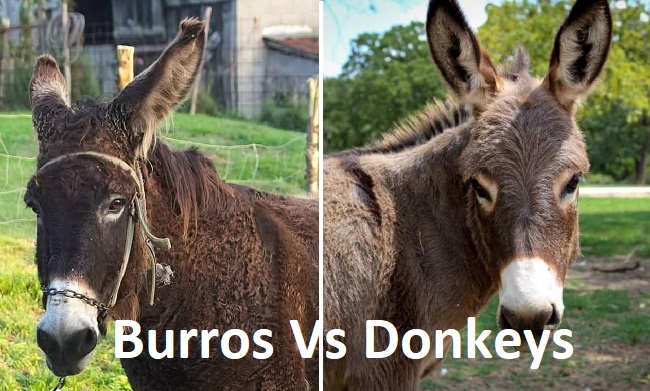The terms “Burros” and “Donkeys” are often used interchangeably, leading to some confusion. While there are similarities between the two, there are also distinct differences worth noting.
This article aims to shed light on the subject by explaining the subtle distinctions and common traits of Burros and Donkeys.

Understanding Donkeys
Donkeys, scientifically known as Equus asinus, have been used as working animals for more than 5000 years. Known for their resilience, endurance, and intelligence, they play vital roles in transport and agriculture, especially in less economically developed countries.
They have a height range of 31 inches (miniature) to 63 inches (standard), and come in a variety of colors including gray, brown, black, white, and spotted.
Understanding Burros
Burro is the Spanish word for “Donkey”. In the United States, the term “Burro” is used to describe the small, wild Donkeys found predominantly in the southwestern states.
These animals, often referred to as “wild Burros”, are descendants of animals brought over by early explorers and miners. They typically exhibit a gray or brown coat and are known for their robustness and adaptability to arid environments.
Key Differences
Size and Appearance: While there are exceptions, Burros are typically smaller and more robust than many of their Donkey counterparts. Their ears are longer, and they have a distinctive “cross” marking on their back and shoulders, often darker than the rest of their coat.
Habitat: While Donkeys are found worldwide, the term Burro is primarily used in North America, specifically referring to the feral Donkeys of the southwestern United States.
Behavior: Both Donkeys and Burros are known for their hardiness and stubbornness. However, wild Burros, being feral, are more independent and wary of human interaction compared to domestic Donkeys.
The Shared Heritage
Despite their differences, Burros and Donkeys share a common heritage, tracing back to the African wild ass. Both have played significant roles in human history, being reliable partners in transport, agriculture, and even warfare.
Their unique personalities, marked by intelligence and a certain stubbornness, make them beloved animals worldwide.
The Conservation Effort
With the modernization of agriculture and transport, the population of Donkeys and Burros, particularly the wild ones, has been on a decline. Efforts are being made by conservationists and animal welfare organizations to protect these noble creatures and their habitats.
Burros and Donkeys: Conservation Efforts
It’s essential to discuss the crucial conservation efforts in place to protect and preserve Burros and Donkeys worldwide. These hardy animals, despite their resilience and adaptability, face challenges from habitat loss, hunting, and inhumane treatment.
Various organizations are committed to improving the lives of Donkeys and Burros globally. For instance, The Donkey Sanctuary, a UK-based international animal welfare charity, provides support to projects in 35 countries worldwide, striving to transform the quality of life for Donkeys, mules, and people worldwide.
In the U.S., the Wild Burro Project aims to protect the wild Burro populations of the American West. Their goals include promoting public education, enhancing habitat, and developing non-lethal management techniques.
They advocate for these often misunderstood and underappreciated animals, recognizing the significant role they play in the ecosystem.
Burros and Donkeys: Their Contribution to Human Lives
Historically, Burros and Donkeys have played a significant role in human societies. They have been indispensable work animals, particularly in rural and agricultural settings. In many countries, they continue to be a vital part of the rural economy, providing a means of transport for goods and people.
Moreover, Donkeys and Burros also serve therapeutic purposes. Donkey-assisted therapy is becoming increasingly popular, helping individuals, particularly children with special needs, develop emotional and social skills.
Conclusion
In conclusion, while the terms “Burro” and “Donkey” are often used interchangeably, they do have their unique characteristics and contexts.
Whether it’s a wild Burro in the deserts of Nevada or a domestic Donkey in rural Africa, these animals continue to be an essential part of our global heritage and a testament to our long-standing relationship with the animal kingdom.
Understanding and acknowledging these differences and similarities is a step towards ensuring their survival and continued relevance in today’s world.
























